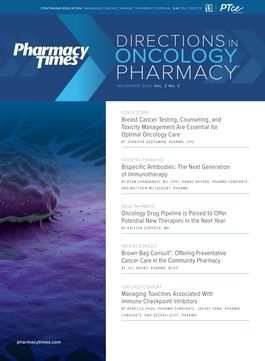Recent Developments in Therapeutics for GIST, Non–Small Cell Lung Cancer
Targeted therapies often have better toxicity profiles, allowing patients to remain adherent and stay on medications longer.
Several new therapeutic options have shown promise over the past year for gastrointestinal stromal tumors (GIST) and non—small cell lung cancer (NCSLC), both of which have thousands of new diagnoses each year, according to an expert panel at the National Association of Specialty Pharmacy (NASP) 2020 Annual Meeting & Expo, held virtually September 14-18.
GIST
GIST is a rare soft tissue sarcoma, with 4000 to 6000 new patients diagnosed with it each year, said presenter Joseph Barone, PharmD, BCOP, senior director of clinical oncology services at Onco360, headquartered in Louisville, Kentucky. The most common sites of involvement include the stomach (60%), small intestine (30%), rectum (4%), colon or appendix (1%-2%), and esophagus (<1%).
Approximately 85% of patients with GIST can receive a complete resection, which Barone said is the ideal scenario. However, up to 50% of patients will relapse without any adjuvant treatment.
Mutations of the KIT gene are extremely common, expressed in approximately 95% of GIST cases. Additionally, 80% of tumors have mutations in the gene encoding the KIT receptor tyrosine kinase.
“Genetic mutations are quite relevant in the treatment of GIST,” Barone said. “Almost all GISTs universally express something called KIT, which is also referred to as CD117. This makes these tumors exquisitely responsive to therapy with imatinib.”
Avapritinib (Ayvakit; Blueprint) and ripretinib (Qinlock; Deciphera) were both approved for the treatment of GIST in the past 12 months, offering new treatment options. Avapritinib tablets are indicated for adults with unresectable or metastatic GIST with a PDGFRA exon 18 mutation. As a tyrosine kinase inhibitor, avapritinib targets PDGFRA and PDGFRA D842 mutations, as well as KIT exon 11, 11/17, and 17 mutations.
The phase 1 NAVIGATOR trial demonstrated an 84% overall response rate (ORR) among patients with a PDGFRA exon 18 mutation who received avapritinib and an 89% ORR among patients with a PDGFRA D842V mutation. Common adverse effects (AEs) include gastrointestinal and central nervous system impacts.
Ripretinib is indicated for adults with advanced GIST who have received prior treatment with 3 or more kinase inhibitors. The phase 3 INVICTUS trial demonstrated a 64% improvement in overall survival for patients receiving ripretinib compared with patients receiving a placebo for the treatment of fourth-line GIST and beyond. It is administered via a standard daily dose of 150 mg orally, either with or without food. Common AEs include alopecia, fatigue, nausea, abdominal pain, and constipation.
NSCLC
Accounting for 85% to 90% of all lung cancer cases, NSCLC is a major area for therapeutic developments. The most common types of NSCLC include large cell carcinoma, adenocarcinoma, and squamous cell carcinoma, according to presenter Allison Kinnarney, BSN, RN, director of clinical programs at Biologics by McKesson.
A major key to improved treatments is the development of more targeted therapies, Kinnarney said in an interview with Pharmacy Times®. Traditional options such as chemotherapy, radiation, and surgical interventions can still be useful. However, Kinnarney said more targeted approaches often have better toxicity profiles, allowing patients to remain more adherent and stay on their medications longer.
“There really is and always has been a great need to treat these patients and to treat them in as much of a targeted way as possible,” Kinnarney said.
Selpercatinib (Retevmo; Eli Lilly and Company) and capmatinib (Tabrecta; Novartis) both offer new, targeted treatment options. Selpercatinib is indicated for adults with metastatic RET fusion—positive NSCLC, for patients aged 12 years and older with advanced or metastatic RET-mutant medullary thyroid cancer who require systemic therapy, and for patients aged 12 and older with advanced RET fusion–positive thyroid cancer that requires systemic therapy that has stopped responding to or is not appropriate for radioactive iodine therapy.
The LIBRETTO-001 trial demonstrated an 85% ORR in RET fusion treatment—naive patients with metastatic NSCLC and a 64% ORR in treatment-experienced patients with metastatic NSCLC. Common AEs include increased alanine aminotransferase and aspartate aminotransferase, increased glucose, decreased leukocytes, dry mouth, diarrhea, and hypertension.
Capmatinib has been FDA approved for adults with metastatic NSCLC whose tumors have a mutation that leads to MET exon 14 skipping. The GEOMETRY mono-1 trial demonstrated a 68% ORR in treatment-naive patients with MET exon 14 skipping and a 41% ORR in treatment-experienced patients. Standard dosing for capmatinib is 400 mg orally twice daily, either with or without food, and is available in 150-mg or 200-mg tablets.
Although the treatment goals for NSCLC are to cure the disease, strategies become more palliative for local advanced or metastatic disease. Kinnarney concluded that a holistic approach to patient care is essential, always balancing toxicity, efficacy, and quality of life.
“As a clinician, you’re really looking to increase overall survival time to hopefully maintain or even possible enhance quality of life for that time,” she said.
REFERENCE
Barone J, and Kinnarney A. NASP state of care 2020: oral oncology. Presented at: National Association of Specialty Pharmacy 2020 Annual Meeting & Expo; September 14-18, 2020; virtual.

